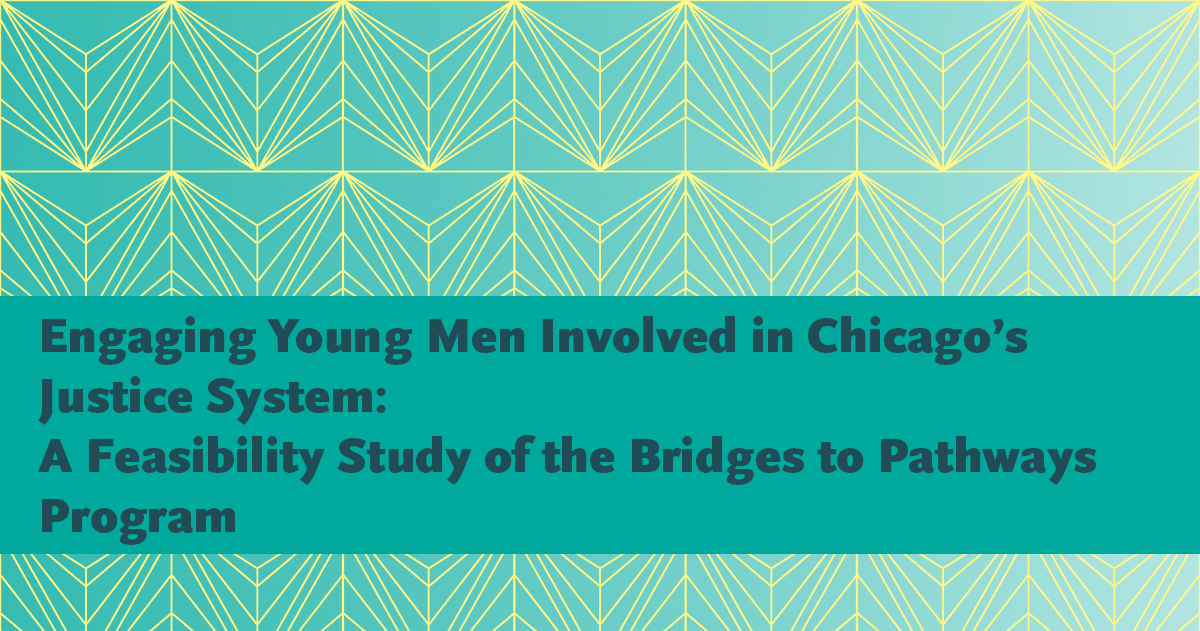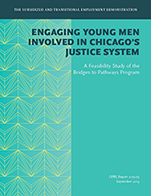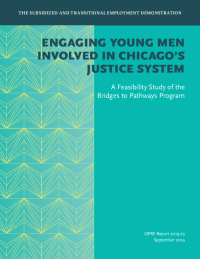Engaging Young Men Involved in Chicago’s Justice System
A Feasibility Study of the Bridges to Pathways Program

 This report presents findings from a feasibility evaluation of the Bridges to Pathways (Bridges) program. Bridges was a program for young men in Chicago between the ages of 17 and 21 years who were involved with the criminal or juvenile justice system and lacked a high school credential. The program offered intensive mentoring and case management, as well as the opportunity to earn a high school credential, attend social-emotional learning workshops, and participate in a subsidized internship.
This report presents findings from a feasibility evaluation of the Bridges to Pathways (Bridges) program. Bridges was a program for young men in Chicago between the ages of 17 and 21 years who were involved with the criminal or juvenile justice system and lacked a high school credential. The program offered intensive mentoring and case management, as well as the opportunity to earn a high school credential, attend social-emotional learning workshops, and participate in a subsidized internship.
The Bridges evaluation is a part of the larger Subsidized and Transitional Employment Demonstration, funded by the Office of Planning, Research, and Evaluation, Administration for Children and Families, in the U.S. Department of Health and Human Services. The Bridges program was launched in 2013, and the evaluation of this developing program builds knowledge about operating this model and its potential to achieve its intended effects: to help participants attain a high school credential, obtain unsubsidized employment, and reduce their involvement with the criminal justice system. Designed as a feasibility assessment, the evaluation includes an implementation study and a small-scale randomized controlled trial.
The Bridges evaluation enrolled 480 young people between June 2015 and July 2016. This report provides a detailed description of the Bridges model and how the program providers adapted the model. It also presents findings about whether the program improved young people’s outcomes and decreased criminal activity during the first year after study enrollment. The implementation study concluded that the program succeeded in enrolling a high-risk population, and it focused its services on keeping participants engaged with the program and removing barriers to their participation. An analysis of the program’s impacts indicates that the program reduced the rate of arrest for felony crimes, and that it also reduced the rate of arrest for violent crimes. However, the program had no impact on the overall rate of arrest or incarceration. It also had no impact on educational or training certification and no sustained effect on employment. Overall, the evaluation indicates that the Bridges model shows promise to help decrease violence among high-risk young men. However, more information will be needed to understand the ability of programs such as Bridges to make a difference in the lives of the young people they serve.
Purpose
Young adults are overrepresented in the criminal justice system. These individuals have a harder time exiting the criminal justice system than their older counterparts, and they face significant challenges when they do, including poorer outcomes in education and employment. Young adults involved with the criminal justice system are becoming recognized as a subset of the “transition-aged youth” population: young people between the ages of 18 and 24 years with distinctive needs stemming from their developmental stage, social interactions, and changing involvement with the justice, education, child welfare, and other systems. Policymakers, practitioners, and advocates are beginning to focus on age-appropriate interventions to help this population abstain from crime and avoid reentering the criminal justice system.
Bridges is a violence prevention program that aims to reduce the likelihood that young adults at high risk of violence will engage in criminal activity. Originally launched in 2013, Bridges closed in 2016 and was revamped in 2017. MDRC evaluated the original Bridges program to determine whether it showed promise for improving the outcomes of the young people it was intended to serve.
Research Questions and Methods
The Bridges evaluation included an implementation study to shed light on the demand for the program and how it operated. Key data sources for the implementation study were staff interviews, observations, and information about young people’s participation in program services collected by the providers. The implementation analysis integrated qualitative and quantitative data from these sources to create a full picture of the implementation of the program.
The evaluation also included a small-scale random assignment study. Individuals who were eligible for and interested in Bridges were randomly assigned to either a program group, which was offered Bridges services, or to a control group, which was not offered those services. The study provides preliminary evidence about the program’s potential to improve short-term outcomes on education, employment, and recidivism. Key data sources included administrative records on involvement in the criminal justice system and records on employment and earnings, as well as a follow-up survey.
The Bridges evaluation seeks to answer the following questions:
- What were the characteristics of the participants who entered Bridges?
- How did the providers implement the program and what adjustments did they make over time?
- What were the duration and intensity of the participants’ engagement in the program?
- What are the preliminary impacts of Bridges on young adults?
Key Findings
- Bridges enrolled a hard-to-reach, high-risk population, made up of young men who were disconnected from education and employment and involved with the criminal justice system.
- Keeping this population engaged was a challenge for the program, which prompted the providers to emphasize services aimed at encouraging young people to persist in the program. Mentoring and case management were key tools the program used to engage participants and facilitate their participation. Ongoing challenges with attendance made it difficult to systematically implement the program’s academic, social-emotional, and employment components.
- The program produced modest increases in access to education, training, and employment services. However, it had no impact on receipt of a high school credential or training certification and did not produce a sustained effect on employment.
The program reduced the rate of arrest for felony crimes by 8 percentage points. Participants were also significantly less likely to be arrested for a violent crime. However, the program had no impacts on the overall rate of arrest or incarceration.






